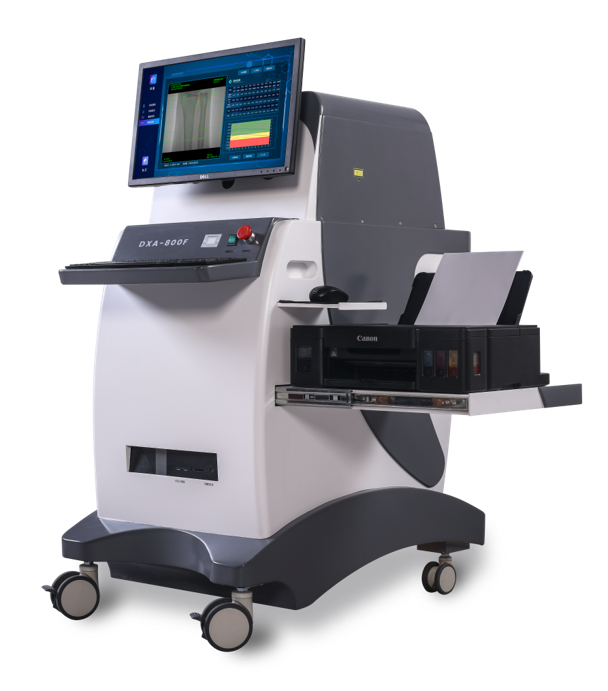Dual-energy X-ray bone densitometer DXA 800F
Application:
Dual-Energy X-ray Absorptiometry (DXA or DEXA) using a very small dose of ionizing radiation to produce pictures of the inside of the forearm to measure bone density . It is evaluating for Osteoporosis and Osteopenia and provides a versatile solution for evaluating the risk of osteoporotic fracture.
It is an enhanced form of X-ray technology that is used to measure bone loss. DXA is today's established standard for measuring bone mineral density (BMD).
Features:
Using digital Laser Beam Positioning Technique
Special Analysis System Based on Different Countries People
Using the Most Advanced Cone - Beam and Surface Imaging Technology.
Measurement Parts: the Front of Forearm
With High Measurement Speed and Short Measurement Time.
Adopting the Full Closed Lead Protective Window to Measure
Technical Parameter:
1. Using the Dual Energy X-ray Absorptimetry.
2. Using the Most Advanced Cone - Beam and Surface Imaging Technology.
3. With High Measurement Speed and Short Measurement Time.
4. With Dual Imaging Technology to Get More Accurate Measurement.
5. Using Laser Beam Positioning Technique, Making the Measuring Position More Accurate.
6. Dectcing Image Digitization, to Get Accurate Measurement Results.
7. Adopting the Surface Imaging Technology, Measuring Faster and Better.
8. Using the Unique Algorithms to Get More Accurate Measurement Results.
9. Adopting the Full Closed Lead Protective Window to Measure, only Need to Put the Patient's Arm into the Window. The Equipment is Indirect Contact with the Scanning Parts of the Patient. Easy to Operate for the Doctor. It is Safety for the Patient and Doctor.
10. Adopting Integrated Structure Design
11. Unique Shape, Beautiful Appearance and Easy to Use.
Performance Parameter:
1. Measurement Parts: the Front of Forearm.
2. X ray tube voltage:High Energy 70 Kv, Low Energy 45Kv.
3. The high and low energy corresponds to the current, 0.25 mA at high energy and 0.45mA at low energy
4. X-Ray Detector:Imported High Sensitivity Digital Camera.
5. X-Ray Source:Stationary Anode X-ray Tube (with High Frequency and Small Focus)
6. Imaging Way:Cone - Beam and Surface Imaging Technology.
7. Imaging Time:≤ 4 Seconds.
8.Accuracy(error)≤ 0.4%
9. Repeatability Coefficient of Variation CV≤0.40%
10. Measuring Area :>=150mm*110mm
11. Can be connected to hospital HIS system, PACS system
12. Provide Worklist Port with independent upload and download function
13. Measuring Parameter: T- Score, Z-Score, BMD,BMC, Area,Adult percent[%], Age percent[%], BQI (The Bone Quality Index) ,BMI,RRF: Relative Fracture Risk
14. It with multi race clinical database, including: European, American, Asian, Chinese, WHO international compatibility. It measuring the people between the age of 0 and 130.
15. Measuring children over three years older
16. Original Dell Business Computer: ,Intel i5,Quad Core Processor ,
8G,1T,22'inch HD Monitor
17. Operation System: Win7 32-bit / 64 bit ,Win10 64 bit compatible
18. Working Voltage: 220V±10%, 50Hz.
Who Should Get Bone Density Tested
Anyone can get osteoporosis. It's more common among older women, but men can have it, too. Your chances increase as you age.
You should discuss with your doctor whether you need the DXA Bone Test. They may recommend it if you meet any of the following:You're a woman 65 or older
You're a postmenopausal woman 50 or older
You're a woman at the age of menopause and have a high chance for breaking bones
You're a woman who has already been through menopause, younger than 65, and have other things that give you a higher chance of osteoporosis
You're a man 50 or older with other risk factors
You break a bone after 50
You've lost more than 1.5 inches of your adult height
Your posture has gotten more hunched
You're having back pain without any cause
Your periods have stopped or are irregular although you're neither pregnant nor menopausal
You've gotten an organ transplant
You've had a drop in hormone levels
Some types of prescription drugs can cause bone loss. These would include glucocorticoids, a class of drugs used to reduce inflammation. Tell your doctor if you've been on cortisone (Cortone Acetate), (Baycadron, Maxidex, Ozurdex), or prednisone (Deltasone).
Our DXA Bone Densitometry is for the Peripheral test. This measures bone density at your the front of forearm. It is usually cheaper.
Peripheral tests are also a way to screen people, so those who show a greater chance for osteoporosis can get more testing. They are also used for larger people who cannot get the central DXA because of weight limits.






